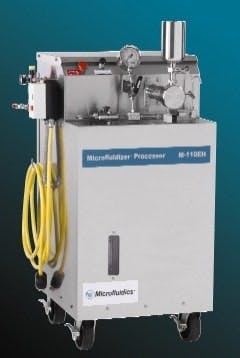Microfluidics will showcase two of its most popular laboratory fluid processors, the M-110Y and M-110EH Microfluidizer processors, in Booth # 1438 at Chem Show 2005, November 1-3 in New York, N.Y. The M-110Y (photo below) is a pneumatic bench top version, while the M-110EH (pictured above) is a plug-in electric-hydraulic floor model on wheels, rounding out a comprehensive line of lab machines for cell disruption, formulation development and other fluid processing applications. The M-110Y is an easily portable lab machine that provides an order of magnitude higher shear rate than any available fluid processor on the market today. The M-110Y processor maximizes the energy-per-unit fluid volume insuring the generation of uniform, submicron particle and droplet sizes. Process pressures are highly variable and reproducible, ranging from a low of 1,500 psi to a high of 23,000 psi. Options available for the M-110Y include a NIST traceable pressure transducer and thermocouple and accessories allowing pressurized sample feed.With process pressures ranging from 2,500 to 25,000 psi, the M-110EH processor maximizes the energy-per-unit fluid volume, resulting in uniform submicron particle and droplet sizes. Equipped with a single acting intensifier pump that amplifies the hydraulic pressure at the simple turn of a knob, the M-110EH drives the product through the interaction chamber at a constant pressure. Options available for the M-110EH processor include a small volume configuration capable of processing samples as small as 25 mL and an explosion-proof version for operation in hazardous environments.
